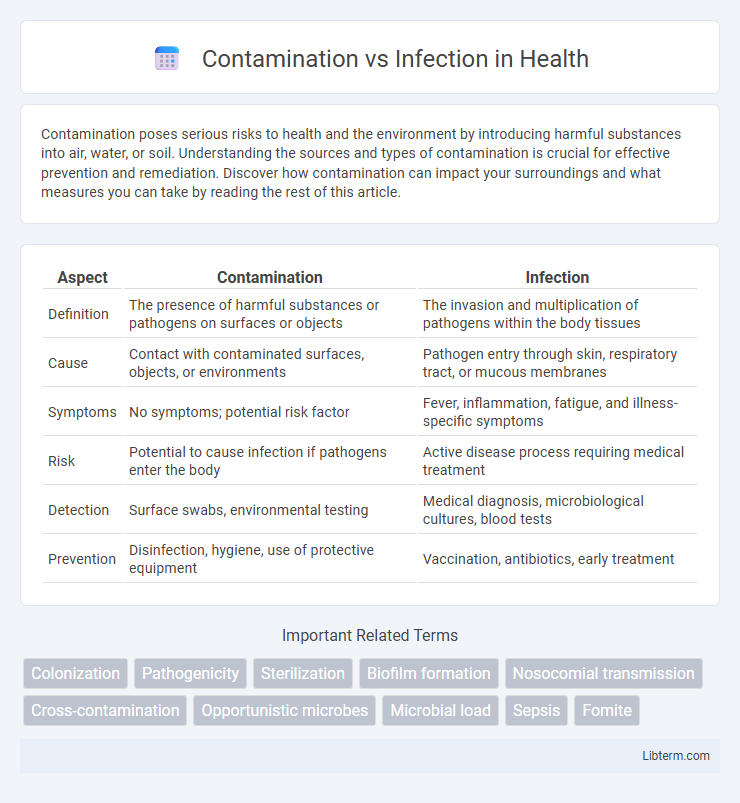Contamination poses serious risks to health and the environment by introducing harmful substances into air, water, or soil. Understanding the sources and types of contamination is crucial for effective prevention and remediation. Discover how contamination can impact your surroundings and what measures you can take by reading the rest of this article.
Table of Comparison
| Aspect | Contamination | Infection |
|---|---|---|
| Definition | The presence of harmful substances or pathogens on surfaces or objects | The invasion and multiplication of pathogens within the body tissues |
| Cause | Contact with contaminated surfaces, objects, or environments | Pathogen entry through skin, respiratory tract, or mucous membranes |
| Symptoms | No symptoms; potential risk factor | Fever, inflammation, fatigue, and illness-specific symptoms |
| Risk | Potential to cause infection if pathogens enter the body | Active disease process requiring medical treatment |
| Detection | Surface swabs, environmental testing | Medical diagnosis, microbiological cultures, blood tests |
| Prevention | Disinfection, hygiene, use of protective equipment | Vaccination, antibiotics, early treatment |
Understanding Contamination and Infection
Contamination occurs when harmful microorganisms or substances are present on a surface or object, posing a risk of transferring pathogens without necessarily causing disease. Infection happens when these pathogens enter the body, multiply, and trigger an immune response, leading to symptoms and illness. Differentiating contamination from infection is crucial for implementing effective hygiene practices and preventing disease spread.
Key Differences Between Contamination and Infection
Contamination refers to the presence of harmful microorganisms or substances on a surface or object without causing disease, whereas infection occurs when these pathogens invade body tissues and multiply, leading to symptoms and illness. Contamination can be transient and is often eliminated through cleaning or disinfection, but infection involves immune response and requires medical treatment. Understanding the distinction is crucial for effective infection control, hygiene practices, and preventing disease transmission.
How Contamination Occurs
Contamination occurs when harmful microorganisms or substances are present on a surface, object, or person but have not yet entered the body or caused illness. It often happens through contact with contaminated surfaces, improperly handled food, or exposure to infectious agents in the environment. Understanding the pathways of contamination is crucial for implementing effective hygiene and sanitation measures to prevent the transition to infection.
Mechanisms of Infection
Infection occurs when pathogenic microorganisms bypass the body's defenses and multiply within tissues, triggering immune responses. The mechanisms of infection include adhesion to host cells, invasion through cellular barriers, and evasion of immune detection via secretion of toxins or biofilm formation. Understanding these processes is critical for developing targeted antimicrobial therapies and preventive measures.
Sources of Contaminants
Sources of contaminants in contamination include environmental surfaces, equipment, hands of healthcare workers, and medical instruments that harbor microorganisms or chemical agents. Infection arises when these contaminants breach the body's natural defenses, typically through wounds, invasive procedures, or respiratory droplets carrying pathogens such as bacteria, viruses, or fungi. Understanding the distinction between external contamination sources and their potential to cause infection is critical for effective infection control and prevention strategies.
Risk Factors for Infection
Risk factors for infection include compromised immune systems, presence of invasive devices such as catheters, and prolonged hospital stays, which increase vulnerability to pathogenic microorganisms. Environmental contamination by bacteria, viruses, or fungi can serve as reservoirs, but infection occurs only when these pathogens overcome host defenses. Proper hygiene, sterilization protocols, and patient immune status critically influence the likelihood of contamination progressing to infection.
Clinical Signs: Contamination vs Infection
Clinical signs of contamination often include localized redness or foreign material without systemic symptoms, whereas infection presents with inflammation, pain, swelling, warmth, and possible fever indicating immune response. Contamination may not elicit significant tissue damage or systemic involvement, while infection results in tissue destruction and systemic signs like leukocytosis. Early differentiation based on clinical signs is crucial for appropriate treatment and preventing progression from contamination to infection.
Prevention Strategies for Contamination
Preventing contamination involves strict hygiene practices such as thorough handwashing, use of personal protective equipment (PPE), and sterilization of medical instruments. Environmental controls like maintaining clean work surfaces, proper waste disposal, and air filtration systems reduce the presence of pathogens. Implementing routine monitoring and adherence to standard operating procedures ensures contamination is minimized in clinical and laboratory settings.
Managing and Treating Infections
Effective management of infections involves prompt identification of pathogens and appropriate antimicrobial therapy to target the specific infectious agent. Implementing strict hygiene protocols and infection control measures reduces the risk of cross-contamination and limits the spread of infection. Monitoring patient response and adjusting treatment plans based on clinical and laboratory findings ensures optimal recovery and minimizes complications.
Importance of Differentiating Contamination and Infection
Differentiating contamination from infection is crucial to ensure appropriate clinical management and avoid unnecessary antimicrobial use. Contamination involves the presence of non-proliferating microorganisms on a surface or sample, while infection signifies the invasion and multiplication of pathogens causing tissue damage and immune response. Accurate distinction reduces misdiagnosis, prevents antibiotic resistance, and guides targeted therapeutic interventions.
Contamination Infographic

 libterm.com
libterm.com